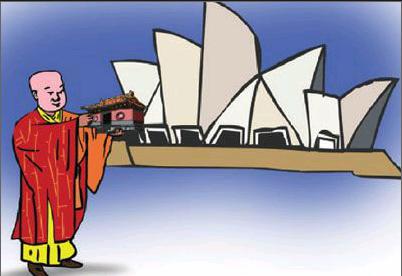Is the Shaolin Temple Overly Commercialized?
2015-05-22

The Shaolin Temple in central Chinas Henan Province, famous for its espousal of martial arts skills, has recently made a splash in the business world by confirming that it has purchased a piece of land in Australia and is planning to build a “temple branch” there. The program also includes a four-star hotel, as well as a golf course.
In recent years, the ancient temple has been involved in a number of commercial activities, challenging the publics traditional conception of a religious organization.
The plan to set up a branch in Australia, which is seen as another step toward commercialization, has split the public right down the middle. While some regard this move as damaging to the temples image as a sacred religious site of worship and pilgrimage, others say this practice will help promote the culture of Buddhism.
Sparking doubts
He Yonghai (www.gmw.cn): Recent years have seen the Shaolin Temple operated more like a business than a religious institute and engaging in ventures encompassing martial arts, the tea industry, tourism and film production. Theres no getting away from the fact that Shaolin is now a multimilliondollar brand. With its plan to open a branch in Australia, the Shaolin Temple seems no longer to be a temple in the traditional sense, but instead a transnational company.
Discussing its new program in Australia, Shi Yongxin, Abbot of the Shaolin Temple, explained that setting up a branch outside China will be conducive to the spread of Shaolin culture and its burgeoning overseas popularity. He said that following the spirit of globalization, Chinas Buddhism culture should go out and make a greater contribution to the diversification of world culture. Chinas kungfu, represented by Shaolin martial arts, is indeed famous across the world. However, is it necessary to set up a branch outside China in order to export Shaolin culture?
Setting up such a branch will cost a lot of money and represents a waste of resources. The program in Australia costs 1.76 billion yuan ($283 million), most of which comprises Buddhist believers donations to the temple. How will these people feel after discovering that their donations will be used to build up a branch in Australia? It would be better for the temple to spend the money improving local peoples livelihood than setting up a branch far away in another country.
The final goal of this is commercial expansion, under the guise of promoting religious culture. Its well known that temples are places for believers to conduct religious activities and express their beliefs. They are supposed to represent curators of religious history and culture instead of businesspeople. However, in recent years, the Shaolin Temple has paid the publics criticism no heed and insisted on moving forward with commercialization.
If it does want to spread its ancient religious culture overseas, the Shaolin Temple can recruit foreign disciples. It can also send its monks to perform martial arts and disseminate the associated culture abroad. Conducting real estate and tourism programs in the name of religious and cultural promotion is utterly improper.
Wang Yahuang (www.cb.com.cn): Abbot Shi has recently asked why he and his disciples cannot export Shaolin culture overseas since China can import Disney from abroad.
Disputes over the Shaolin Temples Australian plan center on how the temple should position itself. Shi said the temple means to serve local Buddhists. Whether this will be successful remains unknown. In addition, Shis comparison of the expansion of the Shaolin Temple to that of the U.S. entertainment giant is virtually inviting public doubts and even derision. Owing to excessive commercialization in the past years, together with other factors, the Shaolin brand is fast losing its luster in China. Nevertheless,it is still highly valued outside the country. Shaolin monks excellent performances are, in particular, winning the temple increasing international recognition.
When its branch is set up in Australia, the temple will no doubt expect to see foreign demand for the opening of branches in even more locations. It is likely we will see the Shaolin Temple become a flourishing franchise in the mould of Disneyland. But once this happens, will the brand then find itself facing backlash and declining reputation in its host countries as it has in China?
Promoting culture
Wang Jiangtao (Baotou Evening News): Most of the news items on the Shaolin Temple highlight the incongruity between peoples outdated conceptions of “ancient temples hidden deep in the forest” and the secular ones now encountered in real life. This time around, confirmation that a four-star hotel and a golf course are to be built alongside a Shaolin branch led to criticisms being once again leveled at the organization, mostly to the effect that such actions run contrary to the Buddhist creed.
However, based on the past three decades of development, this temple branch is likely to be a successful attempt to promote Buddhism. The Shaolin Temple, a 1982 movie starring Jet Li, garnered international fame for both the temple and its attendant Buddhist culture. In recent years, kungfu monks from the Shaolin Temple have toured around the world to perform martial arts. Buddhist monks are required to keep inner peace, but the efforts to spread Buddhist culture will inevitably bring them to the secular world.
In ancient times, temples were indeed hidden in mountains. Nonetheless, they managed to keep in touch with their followers. Today, we have more convenient transportation networks and modern channels for spreading information. Its great that the Shaolin Temple is making itself better known through its involvement in various activities and use of new media like the Internet.
This is actually not the first time that the Chinese have engaged in such activities. Jianzhen (688-763), a renowned monk in the Tang Dynasty (618-907), traveled to Japan to promote Buddhism, and his experience has long been hailed as an example of international cultural communication.
Sun Haigang (blog.ifeng.com): Its hard to believe that such a momentous event, which promotes the spread of Chinas Buddhist culture and boosts employment and tourism in the location in question, has been so vehemently criticized in China. Those opposing the branchs foundation reason that Shaolin monks should concentrate on Buddhist studies and martial arts training rather than doing business.
So is it all right for the Shaolin Temple to open a branch in Australia? In my opinion, if the conditions are ripe, why not? If this program is successfully operated, it will help enhance Chinas cultural influence. Also understandable is the proposed opening of a four-star hotel next to the branch as not all secular disciples are adaptable to life in temples. In addition, if too many visitors were to stay in the temple, the monks might easily be distracted from their daily activities.
People have long harbored the misconception that Buddhists should always lean toward their religious practices such as meditation. However, this varies among schools. While Hinayana adherents may mostly mind their own business and keep to themselves, Mahayana followers are required to influence the rest of the world through their actions. According to their doctrine, they should help others and shoulder social responsibility. Therefore, setting up a Shaolin branch in Australia to popularize Buddhist culture is a noble act that will benefit the overall development of this religion.
